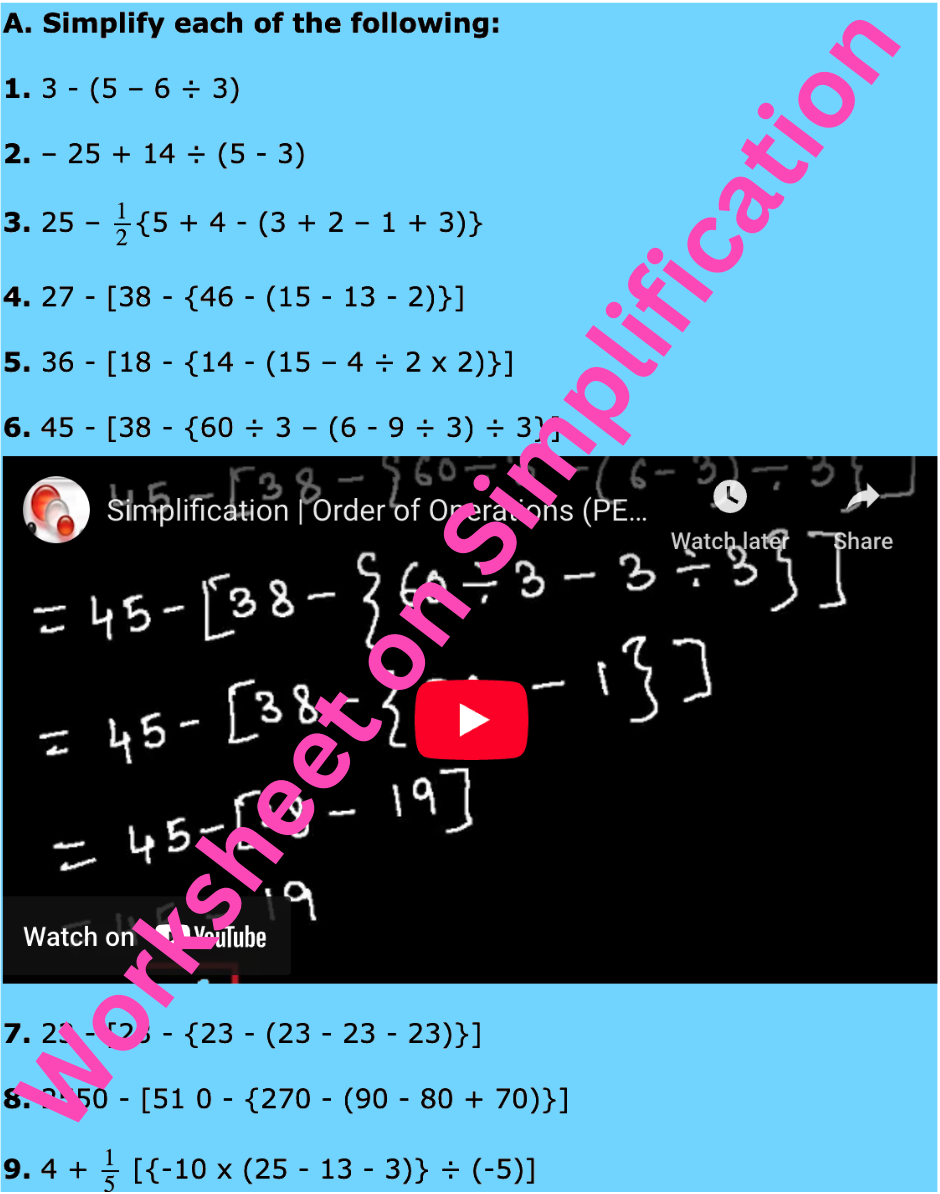Equations
Here we will discuss about equations. An open sentence containing the sign ‘=‘ is called an equation.
Let’s recall how to solve numerical expressions, i.e., 11 + 7 - 3 and algebraic expressions, i.e., 5x - 2 + 10x/2
What is a mathematical sentence?
We already know that the statement 3 + 5 = 8 is true but the statement 7 + 2 = 8 is not true or 2 + 3 < 5 is also not true.
Such mathematical statements which may either be true or false but not both are called mathematical sentences.
What is an open sentence?
The statement 2 + x = 5 may be true or false depending on the value of x.
If x = 1 then 2 + 1 = 5 is false. If x = 3 then 2 + 3 = 5 is true.
Thus, we can say that the mathematical sentence containing the variable becomes either true or false depending upon the value of the variable.
This type of sentence is called an open sentence, thus 2 + x = 5 is an open sentence.
What is an equation?
A statement of equality of two algebraic expressions which involves one or more literals (variables) is called an equation.
3 + x = 7 is an equation.
The set of values of variables which makes the open sentence true is called the solution set.
Note:
Every equation has two sides — L.H.S. (left-hand side) and R.H.S. (right-hand side).
Literals involved in the equation are called variables. These are usually denoted by letters of English alphabet.
An equation may contain any number of variables.
For example:
(i) 5x + 7 = 19 (ii) 2x + 13y = 8 (iii) 5x - 3y + 4z - 14 = 0
Find the solution set for the following open sentences.
(a) x + 4 = 7
(b) x - 3 > 5
(c) x/2 < 10
The solution set for the following open sentences are explained below step-by-step.
(a) x + 4 = 7
Solution:
x + 4 = 7
If x = 0, then 0 + 4 ≠ 7
If x= 1, then 1 + 4 ≠ 7
If x = 2, then 2 + 4 ≠ 7
If x = 3, then 3 + 4 = 7
Therefore, the solution set for the open sentence x + 4 = 7 is 3.
(b) x - 3 > 5
Solution:
x - 3 > 5
If x = 6, then 6 - 3 ≯ 5
If x = 8, then 8 - 3 ≯ 5
If x = 9, then 9 - 3 = 6 > 5
If x = 10, then 10 - 3 > 5
If x = 11, then 11 - 3 > 5
Therefore, the solution set for the open sentence x - 3 > 5 are all the values of the variable greater than 8, i.e., 9, 10, 11, 12...
(c) x/2 < 10
Solution:
x/2 < 10
If x = 24, then 24/2 ≮ 10
If x = 20, then 20/2 ≮ 10
If x = If x = 19/2, then < 10
If x = 16 then 16/2 < 10
Therefore, the solution of the variable less than 20, i.e., 19, 18, 17, 16, 15, 14, ....
● Equations
How to Solve Linear Equations?
Problems on Linear Equations in One Variable
Word Problems on Linear Equations in One Variable
Practice Test on Linear Equations
Practice Test on Word Problems on Linear Equations
● Equations - Worksheets
Worksheet on Word Problems on Linear Equation
7th Grade Math Problems
8th Grade Math Practice
Didn't find what you were looking for? Or want to know more information about Math Only Math. Use this Google Search to find what you need.
Recent Articles
-
Counting Numbers from 1 to 50 | Match the Number | Missing Numbers
Apr 04, 25 03:46 PM
In counting numbers from 1 to 50, recognize the numbers, count and then join the numbers in the correct number order. Here we mainly need eye-hand coordination to draw the picture and maintain the num -
Counting Eleven to Twenty with Numbers and Words |Numbers from 11 - 20
Apr 04, 25 03:21 PM
Counting eleven to twenty with numbers and words are explained below. One ten and one more is eleven. Eleven comes after ten. One ten and two more is twelve. Twelve comes after eleven. -
5th Grade BODMAS Rule Worksheet | PEMDAS | Order of operations|Answers
Apr 03, 25 03:11 PM
In 5th Grade BODMAS Rule Worksheet you will get different types of problems on mathematical expressions involving different operations, mathematical expression with 'brackets' and 'of' and simplifying… -
Worksheet on Simplification | Simplify Expressions | BODMAS Questions
Apr 03, 25 02:58 PM
In worksheet on simplification, the questions are based in order to simplify expressions involving more than one bracket by using the steps of removal of brackets. This exercise sheet -
Divisible by 2 Video |Test of Divisibility by 2 Trick| Rules| Examples
Apr 03, 25 10:25 AM
A number is divisible by 2 if the digit at unit place is either 0 or multiple of 2. So a number is divisible by 2 if digit at its units place is 0, 2, 4, 6 or 8.





New! Comments
Have your say about what you just read! Leave me a comment in the box below. Ask a Question or Answer a Question.